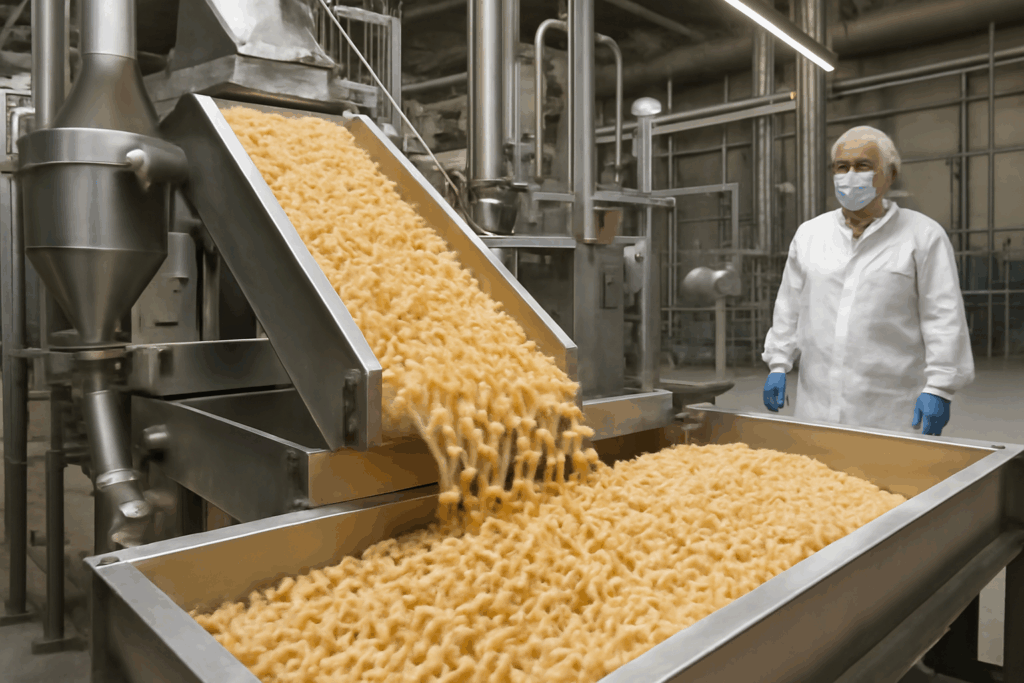The pasta industry has always been a cornerstone of global cuisine, loved by people for its versatility, comforting nature, and rich history. However, in recent years, there has been a significant shift towards innovation. As consumer preferences evolve, the demand for diverse pasta options, including new and exciting flavors, has surged. The introduction of new flavors and ingredients is not only satisfying palates but also boosting the growth of the pasta market. One notable development is the use of the macaroni plant, which has opened doors for fresh, flavor-packed varieties of pasta.
Pasta Market Growth: A Snapshot of the Demand for Variety
The global pasta market has been steadily growing, with projections showing a compound annual growth rate (CAGR) of 3.5% between 2021 and 2028. The rising interest in diverse and healthier pasta options has been a driving force behind this expansion. Consumers are no longer satisfied with just basic wheat-based pasta. Instead, they seek out exotic flavors, healthier alternatives, and plant-based options. Pasta made from the macaroni plant, for instance, is gaining popularity, particularly among those looking for unique, plant-based choices that align with their dietary preferences.
In a survey conducted by the National Pasta Association, 58% of Americans reported enjoying pasta with non-traditional flavors. From spinach-infused fusilli to beetroot pasta, the demand for flavored options continues to grow, and pasta manufacturers are responding with creative, mouthwatering innovations.
The Rise of Flavor Innovations in Pasta
Traditionally, pasta was thought of as a neutral base—perfect for pairing with sauces, cheeses, and meats. But today, pasta is taking on a starring role in meals with bold, vibrant flavors. Flavor innovations are adding excitement to the dining table, and the macaroni plant is one of the standout contributors to this trend.
Herb-Infused Pasta:
One of the most popular flavor trends is herb-infused pasta. Basil, rosemary, and thyme have made their way into pasta varieties, offering a delightful twist on traditional Italian pasta. These herb-infused pastas are ideal for those looking to add some extra depth to their meals.
Vegetable-Based Pastas:
Pasta made with vegetables like spinach, carrot, beetroot, and even sweet potato is becoming a favorite among health-conscious consumers. These vegetables not only enhance the flavor profile of pasta but also add nutritional value, making pasta an even more versatile food.
Flavored Pasta from the Macaroni Plant:
The macaroni plant (also known as the sorghum plant) is making waves in the pasta industry. This ancient grain has been used for centuries in many cultures but is only now being recognized for its potential in pasta production. Pasta made from the macaroni plant offers a slightly nutty flavor and a unique texture. It’s also gluten-free, making it a go-to choice for those with dietary restrictions. As people increasingly look for gluten-free alternatives, macaroni plant-based pasta serves as an ideal substitute.
Cheese and Spice Variations:
For those with a love of bold flavors, cheese- and spice-infused pastas are becoming increasingly popular. Pepper Jack and garlic parmesan pasta are examples of the growing trend of cheesy and spicy pasta varieties. These options offer a more intense flavor experience that satisfies those craving something more complex than traditional pasta.
Exotic Flavors and Fusion Pasta:
Flavors from around the world are also influencing pasta innovation. From Japanese-inspired wasabi pasta to Indian curry-flavored noodles, the fusion of pasta with international spices and ingredients is a growing trend. This not only caters to adventurous eaters but also appeals to the increasing demand for global flavors.
Health and Sustainability: Key Drivers of Flavor Innovation
As consumers become more health-conscious, they are increasingly seeking pasta options that align with their dietary preferences. This is one of the main reasons behind the rise of plant-based, gluten-free, and low-carb pasta varieties.
The macaroni plant, in particular, offers an eco-friendly and nutritious alternative to traditional wheat-based pasta. Sorghum, which is derived from the macaroni plant, is packed with fiber, antioxidants, and essential minerals. It also requires less water to grow than other grains, making it a more sustainable option. This aligns with the growing demand for sustainable and environmentally friendly food choices.
Health-conscious consumers are also gravitating toward pasta made with ancient grains, which are often higher in protein and fiber. Pasta manufacturers are responding by introducing quinoa pasta, farro pasta, and now macaroni plant-based pasta to meet these needs.
The Future of Flavor Innovations in Pasta
Looking ahead, it’s clear that flavor innovation in pasta is far from slowing down. As the global appetite for diverse food experiences grows, pasta producers will continue to experiment with new ingredients and techniques. The macaroni plant is likely to become more central to these innovations, as its versatility and health benefits make it a key ingredient for the future of pasta.
Pasta with exotic flavors, unique plant-based ingredients, and sustainable production methods will likely continue to rise in popularity. Whether it’s for the health benefits, the exciting taste, or the environmental impact, the future of pasta is anything but boring.


